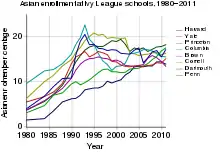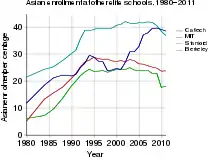Asian quota
An Asian quota is a type of racial quota limiting the number of people of Asian descent in an establishment, a special case of numerus clausus. It usually refers to alleged educational quotas in US higher education admissions, specifically by Ivy League universities against Asian Americans, especially persons of East Asian and South Asian descent starting in the late 1980s. These allegations of discrimination have been denied by US universities. Asian quotas have been compared to earlier claims of Jewish quotas, which are believed to limit the admissions of a model minority from the 1910s to the 1950s. Jewish quotas were denied at the time, but their existence is rarely disputed now.[1][2][3][4] Some have thus called Asian-Americans "The New Jews" of university admissions.[5]


| Part of a series on |
| Discrimination |
|---|
 |
Proponents of Asian quotas' existence believe that by various measures admissions have a bias against Asian applicants, though not necessarily a strict quota: for example, successful Asian applicants have on average higher test scores than the overall average.[6] The perceived bias against applicants of Asian descent has been termed a "bamboo ceiling" or "Asian penalty".[2] Alleged Asian quotas have been the subject of government investigations and lawsuits, with some minor conclusions of their existence, though no major judgements, as of 2017.[7]
Evidence
The primary evidence in favor of the existence of an Asian quota in United States universities admissions is statistical: over the 1990s and 2000s, when the college-age population of Asian-American roughly doubled (and the overall college-age population increased much less), the percentage of admitted Asian-Americans at Ivy League schools not only declined, but converged to a narrow range across different schools, and has stayed relatively constant from year to year.[3] By comparison, at schools that had race-blind policies, such as in the University of California system (notably its prestigious campuses at Berkeley, UCLA, San Diego, Davis, and Irvine) and the California Institute of Technology, Asian-American admissions increased in line with population, and at academic contests, such as International Science Olympiads, Asian representation increased substantially over this period.[4]
Even more surprising has been the sheer constancy of these percentages, with almost every year from 1995–2011 showing an Asian enrollment within a single point of the 16.5 percent average, despite huge fluctuations in the number of applications and the inevitable uncertainty surrounding which students will accept admission. By contrast, prior to 1993 Asian enrollment had often changed quite substantially from year to year. It is interesting to note that this exactly replicates the historical pattern observed by Karabel, in which Jewish enrollment rose very rapidly, leading to imposition of an informal quota system, after which the number of Jews fell substantially, and thereafter remained roughly constant for decades. On the face of it, ethnic enrollment levels which widely diverge from academic performance data or application rates and which remain remarkably static over time provide obvious circumstantial evidence for at least a de facto ethnic quota system.
While California is more Asian than other regions of the United States, it admits students nationally and internationally, and thus the above numbers are not solely reflective of regional demographics. By contrast, in New York City, which has the country's largest urban Asian population, the prestigious specialized high schools of Stuyvesant High School and Bronx Science have majority Asian student bodies, which increased over the 1990s and 2000s, but at Columbia University, which is in the Ivy League, the Asian undergraduate population fell from 22.7% in 1993 to 15.6% in 2011.[4]
Denial
Ivy League universities deny that there is an Asian quota.[8] Due to the sensitivity of college admissions and racial preferences generally, and legal concerns (government investigations, court decisions, and ongoing[9] or future litigation),[10] official statements are largely blanket denials, and a defense of holistic admission, rather than specific answers to charges. Some historians[11] and former admissions officers[12] likewise deny that there is an Asian quota or a bias against Asian applicants, or conclude as much.
More generally, the bias in test scores (the fact that successful Asian applicants have higher test scores than successful applicants overall) is ascribed to applicants being judged on more than test scores.[13] Stated formally, rather than higher test scores among successful Asian applicants meaning that an individual Asian applicant must meet a higher bar than an otherwise identical non-Asian applicant, it may simply be a reflection that Asians have relatively higher test scores: compared to the overall applicant pool, Asians have higher test scores, and a borderline Asian applicant will have higher test scores, but be lower on all other non-academic measures, than the average borderline applicant.
History
Lawsuits
Racial quotas are illegal in United States college admissions, but race can be used as a factor in admissions decisions (affirmative action), as decided in Regents of the Univ. of Cal. v. Bakke (1978) and re-affirmed in Fisher v. University of Texas (2013). Lawsuits have been filed on this basis, including:
Harvard University was sued in 2018 for allegedly downgrading Asian Americans application scores to reduce amount of admission.[14] The United States Justice Department later stated that Harvard did not demonstrate that they did not discriminate during admissions based on race.[15]
References
- Lemann, Nicholas (June 25, 1996). "Jews in Second Place". Slate. Retrieved 2017-08-03.
Just at the moment when Harvard, Yale, and Princeton have presidents named Rudenstine, Levin, and Shapiro, those institutions are widely suspected of having informal ceilings on Asian admissions, of the kind that were imposed on Jews two generations ago.
- English, Bella (June 1, 2015). "To get into elite colleges, some advised to 'appear less Asian'". The Boston Globe. Retrieved 2017-08-03.
The groups say that they are facing the kind of quotas that limited the number of Jews in the nation's best schools through the middle of the 20th century.
- Unz, Ron (May 27, 2014). "Asian Quotas in the Ivy League? "We See Nothing! Nothing!"[Questionable source]". Retrieved 2017-08-03.
In recent years, Asian enrollments at all the Ivies have converged to a very narrow range and remained relatively constant from year to year, a remarkably suspicious result that seems strongly suggestive of an implicit Asian Quota. Indeed, the statistical evidence for a present-day Asian Quota is arguably stronger than that for the notorious Jewish Quota of the Ivies during the 1920s and 1930s, the existence of which was widely denied at the time by university administrators but is now universally accepted.
- Unz, Ron (November 28, 2012). "The Myth of American Meritocracy". The American Conservative. Retrieved 2017-08-03.
- Daniel Golden, The Price of Admission
- "The model minority is losing patience". The Economist. Oct 3, 2015.
- "Challenging Race Sensitive Admission Policies". Public Broadcasting System.
- Neal, Jeff (December 19, 2012). "Harvard Shuns Quotas and Narrow Criteria". The New York Times.
The admissions committee does not use quotas of any kind.
- Chapman, Steve (May 23, 2015). "Harvard's odd quota on Asian-Americans". Chicago Tribune.
When Harvard President Drew Gilpin Faust met with the Tribune Editorial Board this month, she refused to discuss the topic, on the ground that the university is being sued.
- Fernandes, Deirdre (August 3, 2017). "The majority of Harvard's incoming class is nonwhite". The Boston Globe.
Vinay Harpalani, a law professor at Savannah Law School, who specializes in affirmative action[:] "Universities typically don't like to make details on their race-conscious policies public, because the line between legal and illegal policies is not fully clear...and because there are always potential lawsuits out there, and also because this is such a politically charged issue."
- Jerome Karabel, The Chosen (2005), pp. 524-525.
- What It Really Takes to Get into the Ivy League (2003) Chuck Hughes, pp. 86, 145.
- Rod M. Bugarin Jr. (December 19, 2012). "Scores Aren't the Only Qualification". The New York Times.
- Benner, Katie (30 August 2018). "Justice Dept. Backs Suit Accusing Harvard of Discriminating Against Asian-American Applicants". The New York Times. Retrieved 8 September 2018.
- Danilova, Maria; Binkley, Collin; Tucker, Eric (30 August 2018). "Government accuses Harvard of 'outright racial balancing'". AP News. Associated Press. Retrieved 29 July 2020.
Further reading
- Hong, Jane H. Opening the Gates to Asia: A Transpacific History of How America Repealed Asian Exclusion (University of North Carolina Press, 2019) online review